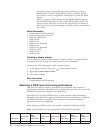
RAID level Sub-logical drive Spanned array logical drive
60 RAID level-6 RAID level-0
With RAID level-10, 1E0, and 50, if one of the physical drives fails in a sub-logical
drive, the ServeRAID controller switches read and write requests to the remaining
functional drives in the sub-logical drive. With RAID level-60, if one or two of the
physical drives fails in a sub-logical drive, the ServeRAID controller switches read
and write requests to the remaining functional drives in the sub-logical drive. With
RAID level-00, a physical drive failure within the sub-logical drive results in loss of
data.
Advantages and disadvantages
RAID level-x0 offers the following advantages and disadvantages.
Advantages Disadvantages
v Supports up to 60 physical drives on SCSI
controllers
v Supports up to 128 physical drives on
SAS and SATA controllers
v 100% data redundancy (except for RAID
level-00)
v Not available on all controllers
v No data redundancy for RAID level-00
More information
v Understanding RAID technology
v Understanding stripe-unit size
v Selecting a RAID level
v RAID level-0
v RAID level-1
v RAID level-1 Enhanced
v RAID level-5
v RAID level-5 Enhanced
v RAID level-5EE
v RAID level-6
v RAID volumes
Understanding RAID volumes
Note: HostRAID controllers do not support RAID volumes.
For ServeRAID SAS controllers (8i/8k/8k-l) and the ServeRAID-7t SATA controller,
the ServeRAID Manager supports the following RAID volume types:
v Simple Volume - a single disk drive or segment; not redundant.
v Spanned Volume - two or more disk drives or segment with the same or
different capacity, connected end-to-end. A spanned volume offers no
redundancy or performance advantage over a single drive.
v RAID Volume - two or more logical drives with the same RAID level,
connected end-to-end. The logical drives may have the same or different
capacity and are not striped together; they may be redundant, depending on the
RAID level.
Notes:
Chapter 3. Using ServeRAID Manager 47


















